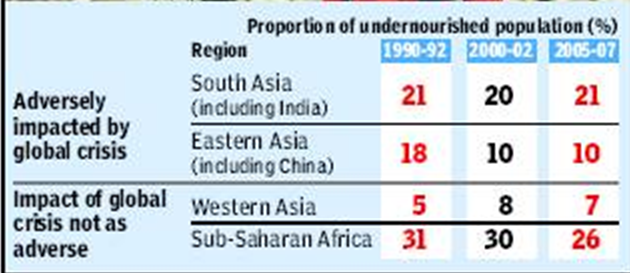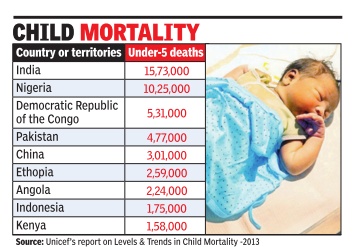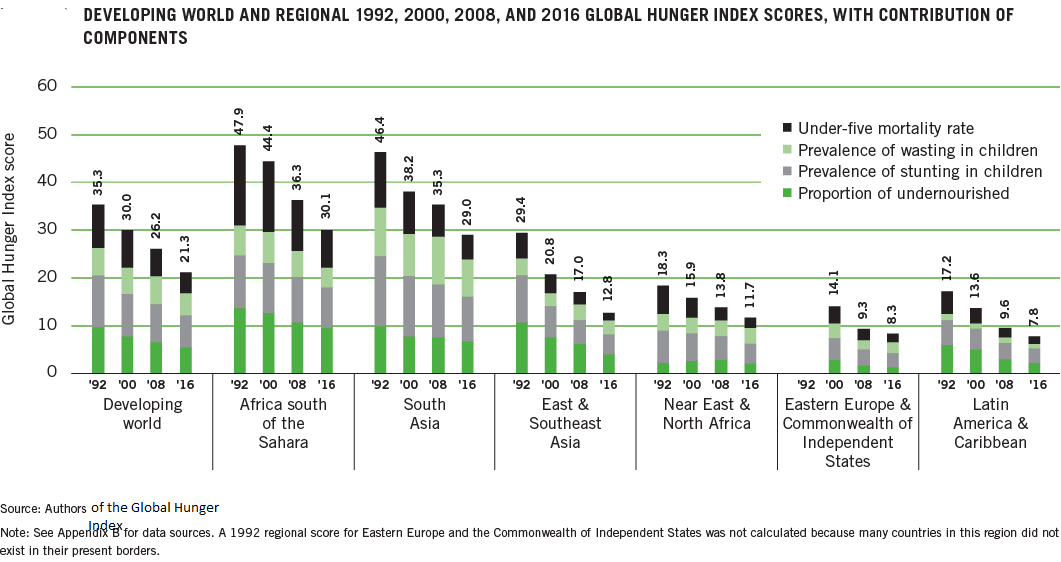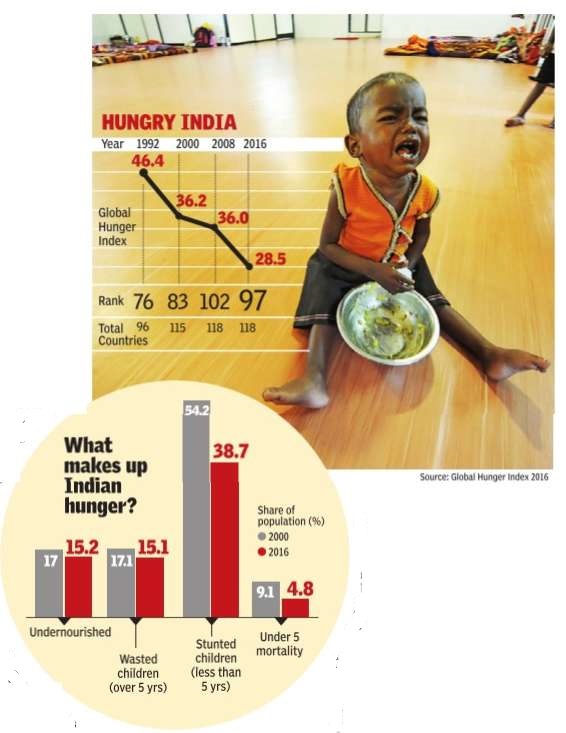Malnutrition in South Asia
(→Global Hunger Index (GHI) 2021) |
|||
| (14 intermediate revisions by 2 users not shown) | |||
| Line 1: | Line 1: | ||
| − | |||
{| class="wikitable" | {| class="wikitable" | ||
| Line 23: | Line 22: | ||
=The extent of the problem= | =The extent of the problem= | ||
| − | == | + | ==1990-2016== |
| − | ''India | + | [[File: Malnutrition in South Asia 2015.jpg| Malnutrition in South Asia: 1990-2016; Graphic courtesy: [http://epaperbeta.timesofindia.com//Gallery.aspx?id=03_06_2015_008_024_005&type=P&artUrl=STATOISTICS-HUNGER-ZONE-03062015008024&eid=31808 ''The Times of India'']|frame|500px]] |
| − | + | ||
| − | + | ||
| − | + | '''See graphic''': | |
| − | + | ''Malnutrition in South Asia: 1990-2016'' | |
| − | + | ||
| − | + | ||
| − | + | ==2004>17: India, Nepal, Sri Lanka improve; Pakistan, Bangladesh, Afghanistan worsen== | |
| + | [https://epaper.timesgroup.com/Olive/ODN/TimesOfIndia/shared/ShowArticle.aspx?doc=TOIDEL%2F2018%2F09%2F17&entity=Ar01712&sk=83D9A198&mode=text Why hunger around the world is rising again, September 17, 2018: ''The Times of India''] | ||
| − | + | [[File: Number of Undernourished people in South Asia, 2004-07 Stunting and wasting of children due to Malnutrition in India.jpg|Number of Undernourished people in South Asia, 2004>17 <br/> Stunting and wasting of children due to Malnutrition in India <br/> From: [https://epaper.timesgroup.com/Olive/ODN/TimesOfIndia/shared/ShowArticle.aspx?doc=TOIDEL%2F2018%2F09%2F17&entity=Ar01712&sk=83D9A198&mode=text Why hunger around the world is rising again, September 17, 2018: ''The Times of India'']|frame|500px]] | |
| − | + | World hunger rose for the third straight year in 2017, jeopardising the progress made to end the scourge of food insecurity that affects vast swathes of the planet. While scientific advancement has ensured great leaps in food production, the causes behind the latest spurt in global hunger are conflict and climate change. A look… | |
| − | |||
| − | |||
| − | |||
| − | + | '''Is the number of undernourished people worldwide declining?''' | |
| − | + | With increasing global wealth one may assume that hunger has been declining over the years. That, however, is not true. Income inequality is increasing and, hence, despite an increase in overall wealth for certain people, the ability to access food has 945 decreased. And not just income inequality, but conflicts, adverse climate and worsened economic conditions, too, have increased the number of undernourished people in some regions. The recent ‘The State of Food Security and Nutrition in the World 2018’ report estimates that in 2017, 10.9% of the world’s population was undernourished. This translates to 821 million people, which is at the same level as that in 2010. Countries in South America and Africa have largely contributed to this increase. | |
| − | + | ||
| − | |||
| − | + | '''How have India and its neighbours performed on combating hunger?''' | |
| − | + | The number of undernourished people has declined in China, India, Nepal and Sri Lanka but has increased in Pakistan, Afghanistan and Bangladesh. However, India still accounts for the world’s largest population of undernourished people and is home to about one in every five undernourished persons. Is climate change contributing to world hunger? | |
| − | + | The food security report points to the role of climate variability and extremes in fuelling global hunger. It says that the number of extreme climate-related disasters has doubled since the early 1990s, with an average of 213 of these events occurring every year during 1990–2016. Additionally, the nature of rainy seasons is also changing. These conditions have an adverse impact on agricultural productivity. Price hikes of essential food, even for a short period, significantly reduces the access to food for underprivileged population. | |
| − | |||
| − | + | '''How does India do on the other hunger indicators?''' | |
| − | + | Indicators of child health are often considered a key pointer for measuring access to nutritious food. Unfortunately, here India paints a sad picture. The latest estimate shows that India is the home of more than 50% of the world’s ‘wasted’ children (child underweight for his/her height) and more than 30% of the world’s stunted children (child shorter for his/her age). In terms of prevalence, both wasting and stunting in India will fall under WHO’s classification that indicates a severe public health issue. | |
| − | + | ==2005-07: Hunger back to 1990 levels in South Asia: UN== | |
| + | ''India Could Miss Meeting Millennium Development Goals '' | ||
| + | |||
| + | Himanshi Dhawan | ||
| − | + | [http://epaper.timesofindia.com/Default/Client.asp?Daily=CAP&showST=true&login=default&pub=TOI&Enter=true&Skin=TOINEW&AW=1393708348876 Times of India] | |
| − | + | [[File: hunger.png | |frame|500px]] | |
| + | |||
| + | New Delhi: Even before the food and financial crises hit the world, prevalence of hunger in South Asia was increasing instead of decreasing, taking the region further away from the goal of reducing hunger by half by 2015, according to the United Nations Millennium Development Goals report, 2010. | ||
| − | + | The report says in 2005-2007, the proportion of undernourished people in South Asia had swelled to levels last seen in 1990. The prevalence of hunger had increased from 20% in 2000-2002 to 21% in 2005-2007. The regional average was 21% in 1990-92, indicating that no progress had been made in the last two decades in reducing hunger levels and that India — the dominant country in the region — will not be able to meet its millennium development goals. | |
| − | + | ||
| − | + | The situation has only worsened since 2007. According to UN figures, the employment to population ratio in South Asia fell to 56% in 2008 from 57% in 1998. The 2009 estimates put it even lower at 55%. An International Labour Organization report says more people got into vulnerable jobs in 2009 due to the financial meltdown. The proportion of employed people living under $1.25 a day jumped sharply from 44% in 2008 to 51% in 2009. | |
| − | + | The UN’s latest millennium development goals report — to be released on Wednesday — says that aggregate food availability globally was relatively good in 2008 and 2009 but higher food prices and reduced employment and incomes meant that the poor had less access to that food. | |
| − | + | ||
| − | + | Food prices spiked in 2008 and falling income due to the financial crisis further worsened the situation. UN’s Food and Agricultural Organization estimates that globally, the number of people who were undernourished in 2008 could have been as high as 915 million and exceeded one billion in 2009. | |
| + | |||
| + | Ironically, before the onset of the global crisis, a number of regions were well on their way to halving the proportion of their undernourished population by 2015. The prevalence of hunger also declined in Sub-Saharan Africa although not at a pace that was sufficiently fast to compensate for population growth and to put the region on track to meet the MDG target. | ||
| + | |||
| + | In East Asia, after a striking drop in the prevalence of hunger in the 1990s, the rate of malnourishment has stalled at 10% between 2000 and 2007. Southeast Asia, which was already close to the target of cutting the hunger rate in half against 1990 levels, made additional progress, but not as rapid as its rate of poverty reduction. | ||
| − | |||
==2013: under-five deaths in India, Pakistan== | ==2013: under-five deaths in India, Pakistan== | ||
[http://epaperbeta.timesofindia.com//Article.aspx?eid=31808&articlexml=In-2013-22-of-all-under-5-deaths-29032015019022 ''The Times of India''] | [http://epaperbeta.timesofindia.com//Article.aspx?eid=31808&articlexml=In-2013-22-of-all-under-5-deaths-29032015019022 ''The Times of India''] | ||
| Line 100: | Line 96: | ||
The paper cites Kerala, Manipur, Mizoram and Sikkim to point out that states where 80% or more of the rural population has access to toilets also have the lowest levels of child malnutrition.However, child malnutrition rates are high in states like Madhya Pradesh, Bihar and Jharkhand, where most households are with-out toilets. Apart from poor sanitation, food insecurity, lack of health care and extremely poor conditions of public health are considered major causes of malnutrition. | The paper cites Kerala, Manipur, Mizoram and Sikkim to point out that states where 80% or more of the rural population has access to toilets also have the lowest levels of child malnutrition.However, child malnutrition rates are high in states like Madhya Pradesh, Bihar and Jharkhand, where most households are with-out toilets. Apart from poor sanitation, food insecurity, lack of health care and extremely poor conditions of public health are considered major causes of malnutrition. | ||
| − | |||
| − | |||
| − | |||
| − | + | ==2015-16: India and Pakistan== | |
| + | [https://epaper.timesgroup.com/Olive/ODN/TimesOfIndia/shared/ShowArticle.aspx?doc=TOIDEL%2F2018%2F11%2F30&entity=Ar01300&sk=8C302A03&mode=text Sushmi Dey, 1/3 of world’s stunted kids are from India, says report, November 30, 2018: ''The Times of India''] | ||
| − | + | [[File: Malnutrition in India and Pakistan- 2015-16.jpg|Malnutrition in India and Pakistan- 2015-16 <br/> From: [https://epaper.timesgroup.com/Olive/ODN/TimesOfIndia/shared/ShowArticle.aspx?doc=TOIDEL%2F2018%2F11%2F30&entity=Ar01300&sk=8C302A03&mode=text Sushmi Dey, 1/3 of world’s stunted kids are from India, says report, November 30, 2018: ''The Times of India'']|frame|500px]] | |
| − | + | ||
| − | |||
| − | + | ''Also Home To Huge Number Of Wasted & Overweight Kids'' | |
| − | + | India is among the countries accounting for the highest burden of stunted, wasted and overweight children, the new Global Nutrition Report, 2018 reflecting the growing concern around child nutrition in the country. | |
| − | + | With 46.6 million stunted children, India accounted for nearly one-third of the world’s 150.8 million children who are stunted, the report shows. India is followed by Nigeria (13.9 million) and Pakistan (10.7 million). The three countries together are home to almost half of all stunted children in the world. | |
| − | + | This is despite the improvement made by India in reducing stunting since 2005-06. According to the latest National Family Health Survey-4 data, India recorded a 10 percentage point decline in stunting from 48% during 2005-06 to 38.4% in 2015-16. Stunting, or low height for age, is caused by long-term insufficient nutrient-intake and frequent infections. | |
| − | + | ||
| − | + | Underlining the variation in stunting within the country, the report said India is so diverse from state to state, it is important to understand how and why stunting prevalence differs. “The mapping showed that stunting varies greatly from district to district (12.4% to 65.1%), with 239 of 604 districts having stunting levels above 40%,” it said. | |
| − | + | India also accounts for the largest number of wasted children with low weight for height. India recorded 25.5 million children who are wasted. This is more significant because percentage of wasted children has increased in India. According to NFHS-4, percentage of wasted children under five years increased from 19.8% in 2005-06 t0 21% in 2015-16. | |
| − | + | Wasting, usually caused by food shortage or disease, is a strong predictor of mortality among children under five years of age. India figures among the set of countries that have more than a million overweight children. “The figures call for immediate action. Malnutrition is responsible for more ill-health than any other cause,” Corinna Hawkes, co-chair of the report and director of the Centre for Food Policy said. | |
| − | + | ==2017: Unaffordability, not unavailability is the problem== | |
| − | + | [[File: The percentage of the average citizen’s daily income that pays for a single meal in Bangladesh, India, Nepal, Pakistan, Africa and New York State.jpg|The percentage of the average citizen’s daily income that pays for a single meal in Bangladesh, India, Nepal, Pakistan, Africa and New York State <br/> From: [https://epaper.timesgroup.com/Olive/ODN/TimesOfIndia/shared/ShowArticle.aspx?doc=TOIM%2F2018%2F03%2F08&entity=Ar00203&sk=FBED9171&mode=text March 8, 2018: ''The Times of India'']|frame|500px]] | |
| − | + | '''See graphic''': | |
| − | + | ''The percentage of the average citizen’s daily income that pays for a single meal in Bangladesh, India, Nepal, Pakistan, Africa and New York State'' | |
| − | |||
| − | |||
| − | + | = Hunger Index= | |
| + | ==2000, 2006, 2012, 2020== | ||
| + | For the 2020 GHI report, data were assessed for 132 countries. [First world countries were not surveyed.] Out of these, China was ranked joint 1st with 16 other countries. There were sufficient data to calculate 2020 GHI scores for and rank 107 countries Bhutan: no data. Maldives: Not included in the index. | ||
| + | |||
| + | {| border="1" | ||
| + | | valign="middle" | | ||
| + | <center>Rank in 2020</center> | ||
| + | | valign="middle" | | ||
| + | <center>Country</center> | ||
| + | | valign="middle" | | ||
| + | <center>2000</center> | ||
| + | | valign="middle" | | ||
| + | <center>2006</center> | ||
| + | | valign="middle" | | ||
| + | <center>2012</center> | ||
| + | | valign="middle" | | ||
| + | <center>2020</center> | ||
| + | | valign="middle" | | ||
| + | <center>Absolute change since 2000</center> | ||
| + | | valign="middle" | | ||
| + | Percent change since 2000 | ||
| + | |- | ||
| + | | valign="middle" | | ||
| + | <center>1</center> | ||
| + | | valign="middle" | | ||
| + | China | ||
| + | | valign="middle" | | ||
| + | <center>13.6</center> | ||
| + | | valign="middle" | | ||
| + | <center>9.5</center> | ||
| + | | valign="middle" | | ||
| + | <center>2.5<5</center> | ||
| + | | valign="middle" | | ||
| + | <center>2.5<5</center> | ||
| + | | valign="middle" | | ||
| + | <center>-</center> | ||
| + | | valign="middle" | | ||
| + | <center>-</center> | ||
| + | |- | ||
| + | | valign="middle" | | ||
| + | <center>64</center> | ||
| + | | valign="middle" | | ||
| + | Sri Lanka | ||
| + | | valign="middle" | | ||
| + | <center>21.9</center> | ||
| + | | valign="middle" | | ||
| + | <center>19.5</center> | ||
| + | | valign="middle" | | ||
| + | <center>20.1</center> | ||
| + | | valign="middle" | | ||
| + | <center>16.3</center> | ||
| + | | valign="middle" | | ||
| + | <center>-5.6</center> | ||
| + | | valign="middle" | | ||
| + | <center>-25.6</center> | ||
| + | |- | ||
| + | | valign="middle" | | ||
| + | <center>73</center> | ||
| + | | valign="middle" | | ||
| + | Nepal | ||
| + | | valign="middle" | | ||
| + | <center>37.4</center> | ||
| + | | valign="middle" | | ||
| + | <center>31.0</center> | ||
| + | | valign="middle" | | ||
| + | <center>22.8</center> | ||
| + | | valign="middle" | | ||
| + | <center>19.5</center> | ||
| + | | valign="middle" | | ||
| + | <center>-17.9</center> | ||
| + | | valign="middle" | | ||
| + | <center>-47.9</center> | ||
| + | |- | ||
| + | | valign="middle" | | ||
| + | <center>75</center> | ||
| + | | valign="middle" | | ||
| + | Bangladesh | ||
| + | | valign="middle" | | ||
| + | <center>34.1</center> | ||
| + | | valign="middle" | | ||
| + | <center>29.0</center> | ||
| + | | valign="middle" | | ||
| + | <center>27.8</center> | ||
| + | | valign="middle" | | ||
| + | <center>20.4</center> | ||
| + | | valign="middle" | | ||
| + | <center>-13.7</center> | ||
| + | | valign="middle" | | ||
| + | <center>-40.2</center> | ||
| + | |- | ||
| + | | valign="middle" | | ||
| + | <center>78</center> | ||
| + | | valign="middle" | | ||
| + | Myanmar | ||
| + | | valign="middle" | | ||
| + | <center>39.8</center> | ||
| + | | valign="middle" | | ||
| + | <center>31.8</center> | ||
| + | | valign="middle" | | ||
| + | <center>23.3</center> | ||
| + | | valign="middle" | | ||
| + | <center>20.9</center> | ||
| + | | valign="middle" | | ||
| + | <center>-18.9</center> | ||
| + | | valign="middle" | | ||
| + | <center>-47.5</center> | ||
| + | |- | ||
| + | | valign="middle" | | ||
| + | <center>88</center> | ||
| + | | valign="middle" | | ||
| + | Pakistan | ||
| + | | valign="middle" | | ||
| + | <center>37.2</center> | ||
| + | | valign="middle" | | ||
| + | <center>33.5</center> | ||
| + | | valign="middle" | | ||
| + | <center>32.8</center> | ||
| + | | valign="middle" | | ||
| + | <center>24.6</center> | ||
| + | | valign="middle" | | ||
| + | <center>-12.6</center> | ||
| + | | valign="middle" | | ||
| + | <center>-33.9</center> | ||
| + | |- | ||
| + | | valign="middle" | | ||
| + | <center>94</center> | ||
| + | | valign="middle" | | ||
| + | India | ||
| + | | valign="middle" | | ||
| + | <center>38.9</center> | ||
| + | | valign="middle" | | ||
| + | <center>37.5</center> | ||
| + | | valign="middle" | | ||
| + | <center>29.3</center> | ||
| + | | valign="middle" | | ||
| + | <center>27.2</center> | ||
| + | | valign="middle" | | ||
| + | <center>-11.7</center> | ||
| + | | valign="middle" | | ||
| + | <center>-30.1</center> | ||
| + | |- | ||
| + | | valign="middle" | | ||
| + | <center>99</center> | ||
| + | | valign="middle" | | ||
| + | Afghanistan | ||
| + | | valign="middle" | | ||
| + | <center>51.0</center> | ||
| + | | valign="middle" | | ||
| + | <center>42.8</center> | ||
| + | | valign="middle" | | ||
| + | <center>33.8</center> | ||
| + | | valign="middle" | | ||
| + | <center>30.3</center> | ||
| + | | valign="middle" | | ||
| + | <center>-20.7</center> | ||
| + | | valign="middle" | | ||
| + | <center>-40.6</center> | ||
| + | |- | ||
| + | | valign="middle" | | ||
| + | <center>ND</center> | ||
| + | | valign="middle" | | ||
| + | Bhutan | ||
| + | | valign="middle" | | ||
| + | <center>-</center> | ||
| + | | valign="middle" | | ||
| + | <center>-</center> | ||
| + | | valign="middle" | | ||
| + | <center>-</center> | ||
| + | | valign="middle" | | ||
| + | <center>-</center> | ||
| + | | valign="middle" | | ||
| + | <center>-</center> | ||
| + | | valign="middle" | | ||
| + | <center>-</center> | ||
| + | |} | ||
| + | |||
| + | [[Category:Afghanistan|M MALNUTRITION IN SOUTH ASIA | ||
| + | MALNUTRITION IN SOUTH ASIA]] | ||
| + | [[Category:Bangladesh|M MALNUTRITION IN SOUTH ASIA | ||
| + | MALNUTRITION IN SOUTH ASIA]] | ||
| + | [[Category:Bhutan|M MALNUTRITION IN SOUTH ASIA | ||
| + | MALNUTRITION IN SOUTH ASIA]] | ||
| + | [[Category:China|M MALNUTRITION IN SOUTH ASIA | ||
| + | MALNUTRITION IN SOUTH ASIA]] | ||
| + | [[Category:Development|M MALNUTRITION IN SOUTH ASIA | ||
| + | MALNUTRITION IN SOUTH ASIA]] | ||
| + | [[Category:Health|MMALNUTRITION IN SOUTH ASIA | ||
| + | MALNUTRITION IN SOUTH ASIA]] | ||
| + | [[Category:India|MMALNUTRITION IN SOUTH ASIA | ||
| + | MALNUTRITION IN SOUTH ASIA]] | ||
| + | [[Category:Myanmar|M MALNUTRITION IN SOUTH ASIA | ||
| + | MALNUTRITION IN SOUTH ASIA]] | ||
| + | [[Category:Pakistan|M MALNUTRITION IN SOUTH ASIA | ||
| + | MALNUTRITION IN SOUTH ASIA]] | ||
| + | [[Category:Sri Lanka|M MALNUTRITION IN SOUTH ASIA | ||
| + | MALNUTRITION IN SOUTH ASIA]] | ||
| + | |||
| + | [[Category:Afghanistan|M MALNUTRITION IN SOUTH ASIAMALNUTRITION IN SOUTH ASIA | ||
| + | MALNUTRITION IN SOUTH ASIA]] | ||
| + | [[Category:Bangladesh|M MALNUTRITION IN SOUTH ASIAMALNUTRITION IN SOUTH ASIA | ||
| + | MALNUTRITION IN SOUTH ASIA]] | ||
| + | [[Category:Bhutan|M MALNUTRITION IN SOUTH ASIAMALNUTRITION IN SOUTH ASIA | ||
| + | MALNUTRITION IN SOUTH ASIA]] | ||
| + | [[Category:China|M MALNUTRITION IN SOUTH ASIAMALNUTRITION IN SOUTH ASIA | ||
| + | MALNUTRITION IN SOUTH ASIA]] | ||
| + | [[Category:Development|M MALNUTRITION IN SOUTH ASIAMALNUTRITION IN SOUTH ASIA | ||
| + | MALNUTRITION IN SOUTH ASIA]] | ||
| + | [[Category:Health|MMALNUTRITION IN SOUTH ASIAMALNUTRITION IN SOUTH ASIA | ||
| + | MALNUTRITION IN SOUTH ASIA]] | ||
| + | [[Category:India|MMALNUTRITION IN SOUTH ASIAMALNUTRITION IN SOUTH ASIA | ||
| + | MALNUTRITION IN SOUTH ASIA]] | ||
| + | [[Category:Myanmar|M MALNUTRITION IN SOUTH ASIAMALNUTRITION IN SOUTH ASIA | ||
| + | MALNUTRITION IN SOUTH ASIA]] | ||
| + | [[Category:Pakistan|M MALNUTRITION IN SOUTH ASIAMALNUTRITION IN SOUTH ASIA | ||
| + | MALNUTRITION IN SOUTH ASIA]] | ||
| + | [[Category:Sri Lanka|M MALNUTRITION IN SOUTH ASIAMALNUTRITION IN SOUTH ASIA | ||
| + | MALNUTRITION IN SOUTH ASIA]] | ||
= Global Hunger Index (GHI) 2016= | = Global Hunger Index (GHI) 2016= | ||
| Line 627: | Line 832: | ||
Now in its 12th year, the GHI ranks countries based on four indicators -undernourishment, child mortality, child wasting and child stunting. IFPRI said more than a fifth of Indian children aged below five weighed too little for their height and over a third were too short for their age. “As of 2015-16, more than a fifth (21%) of children... suffer from wasting (low-weight-forheight) -up from 20% in 2005-2006,“ IFPRI said. Only three other nations -Djibouti, SL and South Sudan -show child wasting above 20% in 2017. | Now in its 12th year, the GHI ranks countries based on four indicators -undernourishment, child mortality, child wasting and child stunting. IFPRI said more than a fifth of Indian children aged below five weighed too little for their height and over a third were too short for their age. “As of 2015-16, more than a fifth (21%) of children... suffer from wasting (low-weight-forheight) -up from 20% in 2005-2006,“ IFPRI said. Only three other nations -Djibouti, SL and South Sudan -show child wasting above 20% in 2017. | ||
| + | |||
| + | =Global Hunger Index (GHI) 2019= | ||
| + | == BRCS, SL, Nepal, BD, Pakistan, all rank above India== | ||
| + | [https://epaper.timesgroup.com/Olive/ODN/TimesOfIndia/shared/ShowArticle.aspx?doc=TOIDEL/2019/10/16&entity=Ar01706&sk=8C16DB24&mode=text Rema.Nagarajan, Oct 16, 2019: ''The Times of India''] | ||
| + | |||
| + | [[File: Global Hunger Index (GHI) 2019 and South Asian and BRICS countries.jpg|Global Hunger Index (GHI) 2019 and South Asian and BRICS countries <br/> From: [https://epaper.timesgroup.com/Olive/ODN/TimesOfIndia/shared/ShowArticle.aspx?doc=TOIDEL/2019/10/16&entity=Ar01706&sk=8C16DB24&mode=text Rema.Nagarajan, Oct 16, 2019: ''The Times of India'']|frame|500px]] | ||
| + | |||
| + | India was ranked 102nd on the Global Hunger Index, an index of 117 countries. It was the lowest ranked among South Asian countries (the rest being ranked between 66 and 94) and way behind the other BRICS nations, the lowest of which was South Africa at 59. | ||
| + | |||
| + | After steady improvement, India’s rank slipped from 2015, when it was ranked 93. Even Pakistan, which used to be the only country in South Asia to rank below India, has pulled ahead in the 2019 ranking to 94th place. | ||
| + | |||
| + | The GHI score, which reflects data from 2014 to 2018, is based on the proportion of a country’s child population that is undernourished, share of children under five years of age who have insufficient weight for their height or whose height is not commensurate to their age, and the mortality rate of under-5 children. | ||
| + | |||
| + | “Because of its large population, India’s GHI indicator values have an outsized impact on the indicator values for the region. India’s child wasting rate is extremely high at 20.8% — the highest wasting rate of any country in this report,” stated the report on the index. The data shows that India’s poor scores were pulling down South Asia to a point where it does worse than even sub-Saharan Africa. | ||
| + | |||
| + | The report said only 9.6% of children between 6-23 months in India were fed a minimum acceptable diet (a recent Union health ministry survey had in fact put that figure at an even lower 6.4%). The GHI report praised the progress made by Bangladesh, attributing it to “robust economic growth and attention to ‘nutrition-sensitive’ sectors such as education, sanitation, and health”. | ||
| + | |||
| + | Nepal has shown the highest percentage change in its ranking since 2000 according to the report, which attributed it to increased household assets (a proxy for household wealth), increased maternal education, improved sanitation, and implementation and use of health and nutrition programs, including antenatal and neonatal care. | ||
| + | |||
| + | The GHI ranks countries on a 100-point scale, with 0 being the best score (no hunger) and 100 being the worst. Values less than 10 reflect low hunger, values from 20 to 34.9 indicate serious hunger; values from 35 to 49.9 are alarming; and values of 50 or more are extremely alarming. | ||
| + | |||
| + | India’s score was 30.3, putting it in the serious hunger category. There were only four countries in the alarming hunger category and the Central African Republic in the extremely alarming hunger category. | ||
| + | |||
| + | The report warned that climate change was causing alarming levels of hunger and making it more difficult to feed people in the world’s most vulnerable regions. Climate change was affecting the quality and safety of food and worsening the nutritional value of cultivated food, it stated. The report pointed out that while there has been progress since 2000, the world has a long way to go to achieve the ‘zero hunger’ target. | ||
| + | |||
| + | |||
| + | =Global Hunger Index (GHI) 2021= | ||
| + | [https://epaper.timesgroup.com/Olive/ODN/TimesOfIndia/shared/ShowArticle.aspx?doc=TOIDEL/2021/10/15&entity=Ar00403&sk=0C7C2C6A&mode=text Oct 15, 2021: ''The Times of India''] | ||
| + | |||
| + | |||
| + | India has slipped to the 101st position in the Global Hunger Index (GHI) 2021 of 116 countries and is behind its neighbours Pakistan, Bangladesh and Nepal. | ||
| + | |||
| + | Eighteen countries, including China, Brazil and Kuwait, shared the top rank with a GHI score of less than five, the website of the Global Hunger Index. which tracks hunger and malnutrition, said. The report, prepared jointly by Irish aid agency Concern Worldwide and German organisation Welt Hunger Hilfe, termed the level of hunger in India “alarming”. | ||
| + | |||
| + | In 2020, India was ranked 94th out of 107 countries. Now with 116 countries in the fray, it has dropped to 101st rank. India’s GHI score has also decelerated — from 38.8 in 2000 to the range of 28.8-27.5 between 2012 and 2021. | ||
| + | |||
| + | The GHI score is calculated on four indicators — undernourishment; child wasting (the share of children under the age of five who are wasted i.e who have low weight for their height, reflecting acute undernutrition); child stunting (children under the age of five who have low height for their age, reflecting chronic undernutrition) and child mortality (the mortality rate of children under the age of five). | ||
| + | “People have been severely hit by Covid-19 and pandemic-related restrictions in India,” the report said. Neighbouring countries like Nepal and Pakistan have fared better at feeding its citizens than India, according to the report. PTI | ||
| + | |||
| + | |||
| + | =Global Hunger Index 2022= | ||
| + | ==India ranks 107th== | ||
| + | [https://www.thehindu.com/news/national/india-ranks-107-out-of-121-countries-on-global-hunger-index/article66010797.ece Jagriti Chandra, Oct 15, 2022: ''The Times of India''] | ||
| + | |||
| + | |||
| + | '''India ranks 107th out of 121 countries on Global Hunger Index''' | ||
| + | |||
| + | India also ranks below Sri Lanka (64), Nepal (81), Bangladesh (84), and Pakistan (99). Afghanistan (109) is the only country in South Asia that performs worse than India on the index. | ||
| + | |||
| + | India ranks 107 out of 121 countries on the Global Hunger Index in which it fares worse than all countries in South Asia barring war-torn Afghanistan. | ||
| + | |||
| + | The Global Hunger Index (GHI) is a tool for comprehensively measuring and tracking hunger at global, regional, and national levels. GHI scores are based on the values of four component indicators - undernourishment, child stunting, child wasting and child mortality. The GHI score is calculated on a 100-point scale reflecting the severity of hunger, where zero is the best score (no hunger) and 100 is the worst. | ||
| + | |||
| + | India’s score of 29.1 places it in the ‘serious’ category. | ||
| + | |||
| + | India also ranks below Sri Lanka (64), Nepal (81), Bangladesh (84), and Pakistan (99). Afghanistan (109) is the only country in South Asia that performs worse than India on the index. | ||
| + | |||
| + | China is among the countries collectively ranked between 1 and 17 having a score of less than five. | ||
| + | |||
| + | [[Category:Afghanistan|M MALNUTRITION IN SOUTH ASIAMALNUTRITION IN SOUTH ASIAMALNUTRITION IN SOUTH ASIAMALNUTRITION IN SOUTH ASIAMALNUTRITION IN SOUTH ASIAMALNUTRITION IN SOUTH ASIA | ||
| + | MALNUTRITION IN SOUTH ASIA]] | ||
| + | [[Category:Bangladesh|M MALNUTRITION IN SOUTH ASIAMALNUTRITION IN SOUTH ASIAMALNUTRITION IN SOUTH ASIAMALNUTRITION IN SOUTH ASIAMALNUTRITION IN SOUTH ASIAMALNUTRITION IN SOUTH ASIA | ||
| + | MALNUTRITION IN SOUTH ASIA]] | ||
| + | [[Category:Bhutan|M MALNUTRITION IN SOUTH ASIAMALNUTRITION IN SOUTH ASIAMALNUTRITION IN SOUTH ASIAMALNUTRITION IN SOUTH ASIAMALNUTRITION IN SOUTH ASIAMALNUTRITION IN SOUTH ASIA | ||
| + | MALNUTRITION IN SOUTH ASIA]] | ||
| + | [[Category:China|M MALNUTRITION IN SOUTH ASIAMALNUTRITION IN SOUTH ASIAMALNUTRITION IN SOUTH ASIAMALNUTRITION IN SOUTH ASIAMALNUTRITION IN SOUTH ASIAMALNUTRITION IN SOUTH ASIA | ||
| + | MALNUTRITION IN SOUTH ASIA]] | ||
| + | [[Category:Development|M MALNUTRITION IN SOUTH ASIAMALNUTRITION IN SOUTH ASIAMALNUTRITION IN SOUTH ASIAMALNUTRITION IN SOUTH ASIAMALNUTRITION IN SOUTH ASIAMALNUTRITION IN SOUTH ASIA | ||
| + | MALNUTRITION IN SOUTH ASIA]] | ||
| + | [[Category:Health|MMALNUTRITION IN SOUTH ASIAMALNUTRITION IN SOUTH ASIAMALNUTRITION IN SOUTH ASIAMALNUTRITION IN SOUTH ASIAMALNUTRITION IN SOUTH ASIAMALNUTRITION IN SOUTH ASIA | ||
| + | MALNUTRITION IN SOUTH ASIA]] | ||
| + | [[Category:India|MMALNUTRITION IN SOUTH ASIAMALNUTRITION IN SOUTH ASIAMALNUTRITION IN SOUTH ASIAMALNUTRITION IN SOUTH ASIAMALNUTRITION IN SOUTH ASIAMALNUTRITION IN SOUTH ASIA | ||
| + | MALNUTRITION IN SOUTH ASIA]] | ||
| + | [[Category:Myanmar|M MALNUTRITION IN SOUTH ASIAMALNUTRITION IN SOUTH ASIAMALNUTRITION IN SOUTH ASIAMALNUTRITION IN SOUTH ASIAMALNUTRITION IN SOUTH ASIAMALNUTRITION IN SOUTH ASIA | ||
| + | MALNUTRITION IN SOUTH ASIA]] | ||
| + | [[Category:Pages with broken file links|MALNUTRITION IN SOUTH ASIAMALNUTRITION IN SOUTH ASIA | ||
| + | MALNUTRITION IN SOUTH ASIA]] | ||
| + | [[Category:Pakistan|M MALNUTRITION IN SOUTH ASIAMALNUTRITION IN SOUTH ASIAMALNUTRITION IN SOUTH ASIAMALNUTRITION IN SOUTH ASIAMALNUTRITION IN SOUTH ASIAMALNUTRITION IN SOUTH ASIA | ||
| + | MALNUTRITION IN SOUTH ASIA]] | ||
| + | [[Category:Sri Lanka|M MALNUTRITION IN SOUTH ASIAMALNUTRITION IN SOUTH ASIAMALNUTRITION IN SOUTH ASIAMALNUTRITION IN SOUTH ASIAMALNUTRITION IN SOUTH ASIAMALNUTRITION IN SOUTH ASIA | ||
| + | MALNUTRITION IN SOUTH ASIA]] | ||
=See also= | =See also= | ||
| + | [[Malnutrition: India]] | ||
| + | |||
| + | [[Category:Afghanistan|M MALNUTRITION IN SOUTH ASIAMALNUTRITION IN SOUTH ASIAMALNUTRITION IN SOUTH ASIAMALNUTRITION IN SOUTH ASIAMALNUTRITION IN SOUTH ASIA | ||
| + | MALNUTRITION IN SOUTH ASIA]] | ||
| + | [[Category:Bangladesh|M MALNUTRITION IN SOUTH ASIAMALNUTRITION IN SOUTH ASIAMALNUTRITION IN SOUTH ASIAMALNUTRITION IN SOUTH ASIAMALNUTRITION IN SOUTH ASIA | ||
| + | MALNUTRITION IN SOUTH ASIA]] | ||
| + | [[Category:Bhutan|M MALNUTRITION IN SOUTH ASIAMALNUTRITION IN SOUTH ASIAMALNUTRITION IN SOUTH ASIAMALNUTRITION IN SOUTH ASIAMALNUTRITION IN SOUTH ASIA | ||
| + | MALNUTRITION IN SOUTH ASIA]] | ||
| + | [[Category:China|M MALNUTRITION IN SOUTH ASIAMALNUTRITION IN SOUTH ASIAMALNUTRITION IN SOUTH ASIAMALNUTRITION IN SOUTH ASIAMALNUTRITION IN SOUTH ASIA | ||
| + | MALNUTRITION IN SOUTH ASIA]] | ||
| + | [[Category:Development|M MALNUTRITION IN SOUTH ASIAMALNUTRITION IN SOUTH ASIAMALNUTRITION IN SOUTH ASIAMALNUTRITION IN SOUTH ASIAMALNUTRITION IN SOUTH ASIA | ||
| + | MALNUTRITION IN SOUTH ASIA]] | ||
| + | [[Category:Health|MMALNUTRITION IN SOUTH ASIAMALNUTRITION IN SOUTH ASIAMALNUTRITION IN SOUTH ASIAMALNUTRITION IN SOUTH ASIAMALNUTRITION IN SOUTH ASIA | ||
| + | MALNUTRITION IN SOUTH ASIA]] | ||
| + | [[Category:India|MMALNUTRITION IN SOUTH ASIAMALNUTRITION IN SOUTH ASIAMALNUTRITION IN SOUTH ASIAMALNUTRITION IN SOUTH ASIAMALNUTRITION IN SOUTH ASIA | ||
| + | MALNUTRITION IN SOUTH ASIA]] | ||
| + | [[Category:Myanmar|M MALNUTRITION IN SOUTH ASIAMALNUTRITION IN SOUTH ASIAMALNUTRITION IN SOUTH ASIAMALNUTRITION IN SOUTH ASIAMALNUTRITION IN SOUTH ASIA | ||
| + | MALNUTRITION IN SOUTH ASIA]] | ||
| + | [[Category:Pages with broken file links|MALNUTRITION IN SOUTH ASIA | ||
| + | MALNUTRITION IN SOUTH ASIA]] | ||
| + | [[Category:Pakistan|M MALNUTRITION IN SOUTH ASIAMALNUTRITION IN SOUTH ASIAMALNUTRITION IN SOUTH ASIAMALNUTRITION IN SOUTH ASIAMALNUTRITION IN SOUTH ASIA | ||
| + | MALNUTRITION IN SOUTH ASIA]] | ||
| + | [[Category:Sri Lanka|M MALNUTRITION IN SOUTH ASIAMALNUTRITION IN SOUTH ASIAMALNUTRITION IN SOUTH ASIAMALNUTRITION IN SOUTH ASIAMALNUTRITION IN SOUTH ASIA | ||
| + | MALNUTRITION IN SOUTH ASIA]] | ||
Revision as of 06:56, 15 October 2022
This is a collection of articles archived for the excellence of their content. Readers will be able to edit existing articles and post new articles directly |
Contents |
The extent of the problem
1990-2016
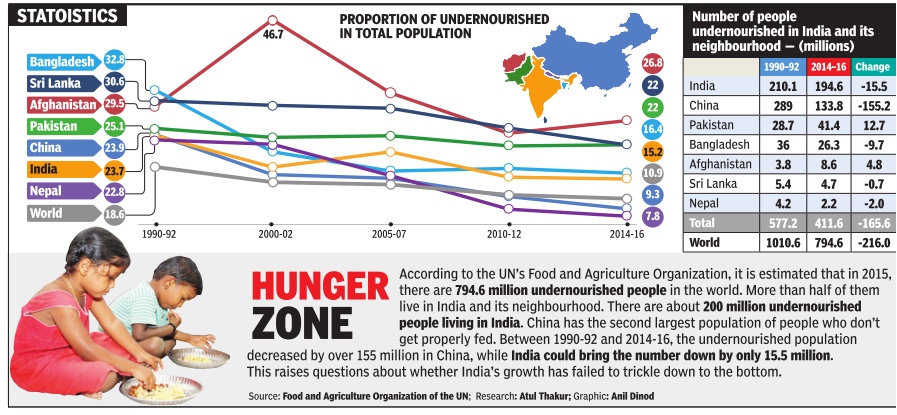
See graphic:
Malnutrition in South Asia: 1990-2016
2004>17: India, Nepal, Sri Lanka improve; Pakistan, Bangladesh, Afghanistan worsen
Why hunger around the world is rising again, September 17, 2018: The Times of India
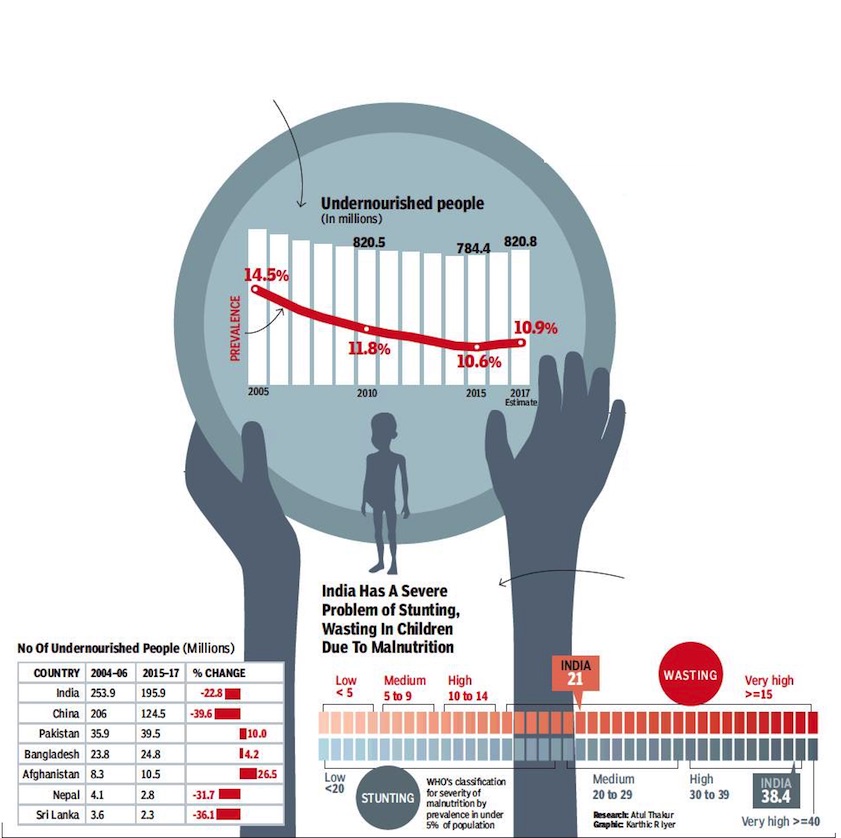
Stunting and wasting of children due to Malnutrition in India
From: Why hunger around the world is rising again, September 17, 2018: The Times of India
World hunger rose for the third straight year in 2017, jeopardising the progress made to end the scourge of food insecurity that affects vast swathes of the planet. While scientific advancement has ensured great leaps in food production, the causes behind the latest spurt in global hunger are conflict and climate change. A look…
Is the number of undernourished people worldwide declining?
With increasing global wealth one may assume that hunger has been declining over the years. That, however, is not true. Income inequality is increasing and, hence, despite an increase in overall wealth for certain people, the ability to access food has 945 decreased. And not just income inequality, but conflicts, adverse climate and worsened economic conditions, too, have increased the number of undernourished people in some regions. The recent ‘The State of Food Security and Nutrition in the World 2018’ report estimates that in 2017, 10.9% of the world’s population was undernourished. This translates to 821 million people, which is at the same level as that in 2010. Countries in South America and Africa have largely contributed to this increase.
How have India and its neighbours performed on combating hunger?
The number of undernourished people has declined in China, India, Nepal and Sri Lanka but has increased in Pakistan, Afghanistan and Bangladesh. However, India still accounts for the world’s largest population of undernourished people and is home to about one in every five undernourished persons. Is climate change contributing to world hunger?
The food security report points to the role of climate variability and extremes in fuelling global hunger. It says that the number of extreme climate-related disasters has doubled since the early 1990s, with an average of 213 of these events occurring every year during 1990–2016. Additionally, the nature of rainy seasons is also changing. These conditions have an adverse impact on agricultural productivity. Price hikes of essential food, even for a short period, significantly reduces the access to food for underprivileged population.
How does India do on the other hunger indicators?
Indicators of child health are often considered a key pointer for measuring access to nutritious food. Unfortunately, here India paints a sad picture. The latest estimate shows that India is the home of more than 50% of the world’s ‘wasted’ children (child underweight for his/her height) and more than 30% of the world’s stunted children (child shorter for his/her age). In terms of prevalence, both wasting and stunting in India will fall under WHO’s classification that indicates a severe public health issue.
2005-07: Hunger back to 1990 levels in South Asia: UN
India Could Miss Meeting Millennium Development Goals
Himanshi Dhawan
New Delhi: Even before the food and financial crises hit the world, prevalence of hunger in South Asia was increasing instead of decreasing, taking the region further away from the goal of reducing hunger by half by 2015, according to the United Nations Millennium Development Goals report, 2010.
The report says in 2005-2007, the proportion of undernourished people in South Asia had swelled to levels last seen in 1990. The prevalence of hunger had increased from 20% in 2000-2002 to 21% in 2005-2007. The regional average was 21% in 1990-92, indicating that no progress had been made in the last two decades in reducing hunger levels and that India — the dominant country in the region — will not be able to meet its millennium development goals.
The situation has only worsened since 2007. According to UN figures, the employment to population ratio in South Asia fell to 56% in 2008 from 57% in 1998. The 2009 estimates put it even lower at 55%. An International Labour Organization report says more people got into vulnerable jobs in 2009 due to the financial meltdown. The proportion of employed people living under $1.25 a day jumped sharply from 44% in 2008 to 51% in 2009.
The UN’s latest millennium development goals report — to be released on Wednesday — says that aggregate food availability globally was relatively good in 2008 and 2009 but higher food prices and reduced employment and incomes meant that the poor had less access to that food.
Food prices spiked in 2008 and falling income due to the financial crisis further worsened the situation. UN’s Food and Agricultural Organization estimates that globally, the number of people who were undernourished in 2008 could have been as high as 915 million and exceeded one billion in 2009.
Ironically, before the onset of the global crisis, a number of regions were well on their way to halving the proportion of their undernourished population by 2015. The prevalence of hunger also declined in Sub-Saharan Africa although not at a pace that was sufficiently fast to compensate for population growth and to put the region on track to meet the MDG target.
In East Asia, after a striking drop in the prevalence of hunger in the 1990s, the rate of malnourishment has stalled at 10% between 2000 and 2007. Southeast Asia, which was already close to the target of cutting the hunger rate in half against 1990 levels, made additional progress, but not as rapid as its rate of poverty reduction.
2013: under-five deaths in India, Pakistan
Mar 29 2015
Sushmi Dey
`In 2013, 22% of all under-5 deaths occurred in India'
Malnutrition is biggest killer: NGO
India accounts for most deaths of children aged below five years every year, with 50% of these caused mainly by malnutrition, a new policy paper has said. The paper, released in March and prepared by NGO Forum for Learning and Action with Innovation and Rigour (FLAIR), estimates that 22% of all under-five deaths worldwide occur in India. In 2013, over 15 lakh such children died in India. A Unicef report supports the figure.
According to the Unicef report, about 50% of the world's under-five deaths occur in just five countries: India, Nigeria, Democratic Republic of the Congo, Pakistan and China. Lack of basic sanitation in India is seen as a key factor for the endemic child malnutrition. “(An) Unhygienic environment combined with high population density creates a perfect storm for diseases to thrive, and malnutrition to flourish,“ says Dr Raj Bhandari, adviser-health and nutrition at FLAIR.
According to Bhandari, the absence of sanitation exposes children to infectious diseases such as typhoid and diarrhoea, which rob them of their ability to absorb nutrients and make them vulnerable, causing co-morbidity .
The paper cites Kerala, Manipur, Mizoram and Sikkim to point out that states where 80% or more of the rural population has access to toilets also have the lowest levels of child malnutrition.However, child malnutrition rates are high in states like Madhya Pradesh, Bihar and Jharkhand, where most households are with-out toilets. Apart from poor sanitation, food insecurity, lack of health care and extremely poor conditions of public health are considered major causes of malnutrition.
2015-16: India and Pakistan
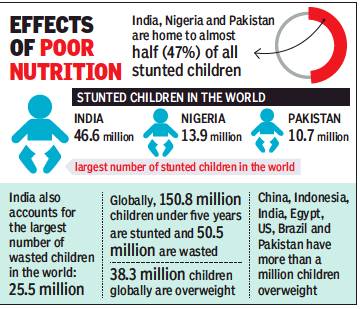
From: Sushmi Dey, 1/3 of world’s stunted kids are from India, says report, November 30, 2018: The Times of India
Also Home To Huge Number Of Wasted & Overweight Kids
India is among the countries accounting for the highest burden of stunted, wasted and overweight children, the new Global Nutrition Report, 2018 reflecting the growing concern around child nutrition in the country.
With 46.6 million stunted children, India accounted for nearly one-third of the world’s 150.8 million children who are stunted, the report shows. India is followed by Nigeria (13.9 million) and Pakistan (10.7 million). The three countries together are home to almost half of all stunted children in the world.
This is despite the improvement made by India in reducing stunting since 2005-06. According to the latest National Family Health Survey-4 data, India recorded a 10 percentage point decline in stunting from 48% during 2005-06 to 38.4% in 2015-16. Stunting, or low height for age, is caused by long-term insufficient nutrient-intake and frequent infections.
Underlining the variation in stunting within the country, the report said India is so diverse from state to state, it is important to understand how and why stunting prevalence differs. “The mapping showed that stunting varies greatly from district to district (12.4% to 65.1%), with 239 of 604 districts having stunting levels above 40%,” it said.
India also accounts for the largest number of wasted children with low weight for height. India recorded 25.5 million children who are wasted. This is more significant because percentage of wasted children has increased in India. According to NFHS-4, percentage of wasted children under five years increased from 19.8% in 2005-06 t0 21% in 2015-16.
Wasting, usually caused by food shortage or disease, is a strong predictor of mortality among children under five years of age. India figures among the set of countries that have more than a million overweight children. “The figures call for immediate action. Malnutrition is responsible for more ill-health than any other cause,” Corinna Hawkes, co-chair of the report and director of the Centre for Food Policy said.
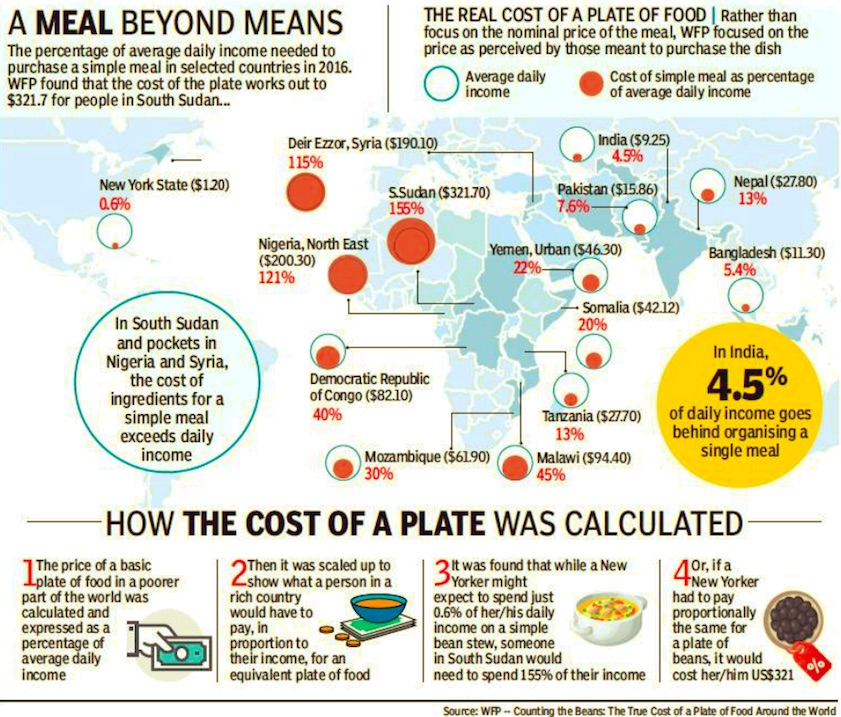
From: March 8, 2018: The Times of India
See graphic:
The percentage of the average citizen’s daily income that pays for a single meal in Bangladesh, India, Nepal, Pakistan, Africa and New York State
Hunger Index
2000, 2006, 2012, 2020
For the 2020 GHI report, data were assessed for 132 countries. [First world countries were not surveyed.] Out of these, China was ranked joint 1st with 16 other countries. There were sufficient data to calculate 2020 GHI scores for and rank 107 countries Bhutan: no data. Maldives: Not included in the index.
|
|
|
|
|
|
|
|
Percent change since 2000 |
|
|
China |
|
|
|
|
|
|
|
|
Sri Lanka |
|
|
|
|
|
|
|
|
Nepal |
|
|
|
|
|
|
|
|
Bangladesh |
|
|
|
|
|
|
|
|
Myanmar |
|
|
|
|
|
|
|
|
Pakistan |
|
|
|
|
|
|
|
|
India |
|
|
|
|
|
|
|
|
Afghanistan |
|
|
|
|
|
|
|
|
Bhutan |
|
|
|
|
|
|
Global Hunger Index (GHI) 2016
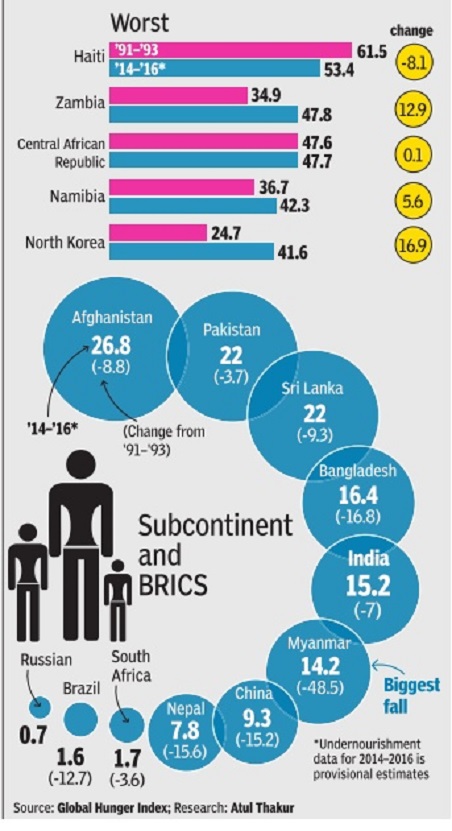
The Times of India
NEW DELHI: India - one of the fastest growing economies in the world - cannot feed its children. This was highlighted once again in the Global Hunger Index (GHI) report released Tuesday which placed the country 97th in a list of 118.
The Global Hunger Index (GHI) is a multidimensional statistical tool used to describe the state of countries' hunger situation. It describes India's hunger situation as "serious." On a 0-100 point scale with 100 being the absolute worst in hunger levels, India scored 28.5 - a marginal improvement of a quarter point since the turn of the century. But with the country all set to be the most populaous in the world in the next 10-odd years, the improvement may well reverse.
Hunger and malnourishment is not just a problem for India. Nuclear rival+ Pakistan fares even worse and was placed 107 in the GHI list. The report said 22 per cent of Pakistani population was undernourished and that it scored 33.4 on the 0-100 point scale - a marginal improvement from its score of 35.1 in 2008. On the other end of the rivalry spectrum, China fares tremendously well despite the sheer size of its population. It is placed 20th with a "low hunger level" rating.
Overall, the Central African Republic, Chad, and Zambia fared the worst while Argentina fared the best among the countries included in the study.
SL, BD, Nepal above India, Pakistan Afghanistan below
Subodh Varma, India below B'desh, Rwanda in global hunger rankings, Oct 13 2016 : The Times of India
29% Drop In Hunger Worldwide But India Slips From 83 To 97 In 16 Yrs
India continues to have serious levels of widespread hunger forcing it to be ranked a lowly 97 among 118 develop ing countries for which the Global Hunger Index (GHI) was calculated this year. Countries worse than India include extremely poor African countries such as Niger, Chad, Ethiopia and Sierra Leone besides two of India's neighbours: Afghanistan and Pakistan. Other neighbours Sri Lanka, Bangladesh, Nepal and China are all ranked above India.
The GHI is calculated by taking into account four key parameters: shares of undernourished population, wasted and stunted children aged under 5, and infant mortality rate of the same age group. Of the 131 countries studied, data was available for 118 countries. This year, for the first time, two measures of child hunger -wasting and stunting -have been used to give a more complete picture. Wasting refers to low weight in relation to a child's height, reflecting acute undernutrition.Stunting refers to the deficiency in height in relation to age, reflecting chronic undernutrition.
The International Food Policy Re search Institute (IFPRI) makes the annual calculations of GHI. Basing its readings on the most recent data, the 2016 GHI for India was derived from the fact that an estimated 15% population is undernourished -lacking in adequate food intake, both in quantity and quality .
The share of under-5 children who are `wasted' is about 15% while the share of children who are `stunted' is a staggering 39%. This reflects widespread and chronic lack of balanced food. The under-5 mortality rate is 4.8% in India, partially reflecting the fatal synergy of inadequate nutrition and unhealthy environments.
Although India runs two of the world's biggest children's nutrition programmes, the ICDS for children under 6 years and the mid-day meal programme for school going kids up to the age of 14, malnutrition continues to haunt India.
Endemic poverty, unemployment, lack of sanitation and safe drinking water, and lack of effective healthcare are main factors for the sorry state. Compared with previous years, marked improvement has taken place in child stunting and under-5 mortality rates but the proportion of undernourished people has declined only marginally from 17% in 2000 to the current 15%. The share of wasted children has inched down similarly. India was ranked 83 in 2000 and 102 in 2008 with GHI scores of 38.2 and 36 respectively. This implies that, while hunger lev els in India have diminished somewhat, the improvement has been outstripped by several other countries. Hence India's ranking is worse today than it was 15 years ago. In fact, Bangladesh was ranked 84 with a score of 38.5 in 2000, just below India. But in 2016, it has improved beyond India with a GHI score of 27.1 and a rank of 90 to India's 97.
Overall, global hunger levels are down by about 29% compared to 2000.Twenty countries, including Rwanda, Cambodia, and Myanmar, have reduced their GHI scores by over 50% each since 2000. And, for the second year in a row, no developing country for which data was available featured in the “extremely alarming“ category .
Table: South Asia on Global Hunger Index (GHI) 2016
|
Country |
Proportion of undernourished in population (%) |
Prevalence of wasting in children under five years (%) |
Prevalence of stunting in children under five years (%) |
Under five mortality rate (%) |
Score |
|
Afghanistan
|
26.8 |
9.5 |
40.9 |
9.1 |
34.8 |
|
Bangladesh
|
16.4 |
14.3 |
36.4 |
3.8 |
27.1 |
|
Bhutan
|
- |
4.4* |
26.9* |
3.3 |
- |
|
China
|
9.3 |
2.1* |
6.8* |
1.1 |
7.7 |
|
India
|
15.2 |
15.1 |
38.7 |
4.8 |
28.5 |
|
Myanmar
|
14.2 |
7.1* |
31* |
5 |
22 |
|
Nepal
|
7.8 |
11.3 |
37.4 |
3.6 |
21.9 |
|
Pakistan
|
22 |
10.5 |
45 |
8.1 |
33.4 |
|
Sri Lanka
|
22 |
21.4 |
14.7 |
1 |
25.5 |
Global Hunger Index (GHI) 2017
Nepal, Myanmar, SL, BD rank above India, Pakistan, Afghanistan
India ranked 100th among 119 as hunger gets worse, October 13, 2017: The Times of India
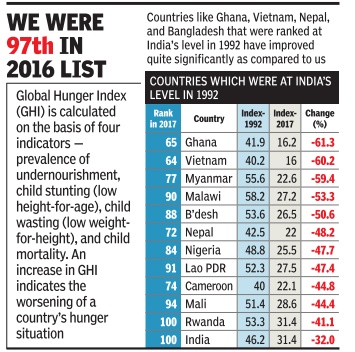
From: India ranked 100th among 119 as hunger gets worse, October 13, 2017: The Times of India
Trails Iraq, Bangladesh, North Korea
Grappling with a “serious“ hunger problem, India has been ranked 100th among 119 developing countries on the Global Hunger Index (GHI), behind North Korea, Bangladesh and even the besieged Iraq, but ahead of Pakistan, according to a report. India was ranked 97th in 2016.
The country's hunger problem is driven by high child malnutrition, and underlines the need for stronger commitment to the social sector, the International Food Policy Research Institute (IFPRI) said in its report.
“India... has the third highest score in all of Asia -only Afghanistan and Pakis tan are ranked worse,“ IFPRI said in a statement. An increase in GHI indicates the worsening of a country's hunger situation. “At 31.4, India's 2017 GHI score is at the high end of the `serious' category, and one of the main factors pushing South Asia to the category of worst performing region in 2017, followed closely by Africa South of the Sahara,“ it added.
Among India's neighbouring countries, China ranks the highest at 29; Nepal has been ranked 72, Myanmar 77, Sri Lanka 84, Bangladesh 88, Pakistan 106 and Afghanistan 107.
Now in its 12th year, the GHI ranks countries based on four indicators -undernourishment, child mortality, child wasting and child stunting. IFPRI said more than a fifth of Indian children aged below five weighed too little for their height and over a third were too short for their age. “As of 2015-16, more than a fifth (21%) of children... suffer from wasting (low-weight-forheight) -up from 20% in 2005-2006,“ IFPRI said. Only three other nations -Djibouti, SL and South Sudan -show child wasting above 20% in 2017.
Global Hunger Index (GHI) 2019
BRCS, SL, Nepal, BD, Pakistan, all rank above India
Rema.Nagarajan, Oct 16, 2019: The Times of India
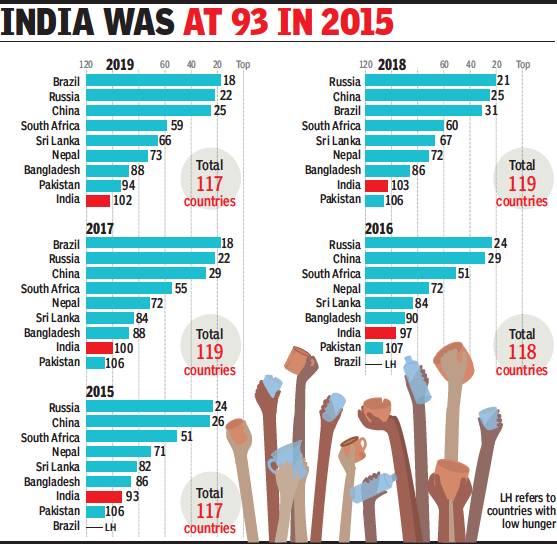
From: Rema.Nagarajan, Oct 16, 2019: The Times of India
India was ranked 102nd on the Global Hunger Index, an index of 117 countries. It was the lowest ranked among South Asian countries (the rest being ranked between 66 and 94) and way behind the other BRICS nations, the lowest of which was South Africa at 59.
After steady improvement, India’s rank slipped from 2015, when it was ranked 93. Even Pakistan, which used to be the only country in South Asia to rank below India, has pulled ahead in the 2019 ranking to 94th place.
The GHI score, which reflects data from 2014 to 2018, is based on the proportion of a country’s child population that is undernourished, share of children under five years of age who have insufficient weight for their height or whose height is not commensurate to their age, and the mortality rate of under-5 children.
“Because of its large population, India’s GHI indicator values have an outsized impact on the indicator values for the region. India’s child wasting rate is extremely high at 20.8% — the highest wasting rate of any country in this report,” stated the report on the index. The data shows that India’s poor scores were pulling down South Asia to a point where it does worse than even sub-Saharan Africa.
The report said only 9.6% of children between 6-23 months in India were fed a minimum acceptable diet (a recent Union health ministry survey had in fact put that figure at an even lower 6.4%). The GHI report praised the progress made by Bangladesh, attributing it to “robust economic growth and attention to ‘nutrition-sensitive’ sectors such as education, sanitation, and health”.
Nepal has shown the highest percentage change in its ranking since 2000 according to the report, which attributed it to increased household assets (a proxy for household wealth), increased maternal education, improved sanitation, and implementation and use of health and nutrition programs, including antenatal and neonatal care.
The GHI ranks countries on a 100-point scale, with 0 being the best score (no hunger) and 100 being the worst. Values less than 10 reflect low hunger, values from 20 to 34.9 indicate serious hunger; values from 35 to 49.9 are alarming; and values of 50 or more are extremely alarming.
India’s score was 30.3, putting it in the serious hunger category. There were only four countries in the alarming hunger category and the Central African Republic in the extremely alarming hunger category.
The report warned that climate change was causing alarming levels of hunger and making it more difficult to feed people in the world’s most vulnerable regions. Climate change was affecting the quality and safety of food and worsening the nutritional value of cultivated food, it stated. The report pointed out that while there has been progress since 2000, the world has a long way to go to achieve the ‘zero hunger’ target.
Global Hunger Index (GHI) 2021
Oct 15, 2021: The Times of India
India has slipped to the 101st position in the Global Hunger Index (GHI) 2021 of 116 countries and is behind its neighbours Pakistan, Bangladesh and Nepal.
Eighteen countries, including China, Brazil and Kuwait, shared the top rank with a GHI score of less than five, the website of the Global Hunger Index. which tracks hunger and malnutrition, said. The report, prepared jointly by Irish aid agency Concern Worldwide and German organisation Welt Hunger Hilfe, termed the level of hunger in India “alarming”.
In 2020, India was ranked 94th out of 107 countries. Now with 116 countries in the fray, it has dropped to 101st rank. India’s GHI score has also decelerated — from 38.8 in 2000 to the range of 28.8-27.5 between 2012 and 2021.
The GHI score is calculated on four indicators — undernourishment; child wasting (the share of children under the age of five who are wasted i.e who have low weight for their height, reflecting acute undernutrition); child stunting (children under the age of five who have low height for their age, reflecting chronic undernutrition) and child mortality (the mortality rate of children under the age of five). “People have been severely hit by Covid-19 and pandemic-related restrictions in India,” the report said. Neighbouring countries like Nepal and Pakistan have fared better at feeding its citizens than India, according to the report. PTI
Global Hunger Index 2022
India ranks 107th
Jagriti Chandra, Oct 15, 2022: The Times of India
India ranks 107th out of 121 countries on Global Hunger Index
India also ranks below Sri Lanka (64), Nepal (81), Bangladesh (84), and Pakistan (99). Afghanistan (109) is the only country in South Asia that performs worse than India on the index.
India ranks 107 out of 121 countries on the Global Hunger Index in which it fares worse than all countries in South Asia barring war-torn Afghanistan.
The Global Hunger Index (GHI) is a tool for comprehensively measuring and tracking hunger at global, regional, and national levels. GHI scores are based on the values of four component indicators - undernourishment, child stunting, child wasting and child mortality. The GHI score is calculated on a 100-point scale reflecting the severity of hunger, where zero is the best score (no hunger) and 100 is the worst.
India’s score of 29.1 places it in the ‘serious’ category.
India also ranks below Sri Lanka (64), Nepal (81), Bangladesh (84), and Pakistan (99). Afghanistan (109) is the only country in South Asia that performs worse than India on the index.
China is among the countries collectively ranked between 1 and 17 having a score of less than five.
